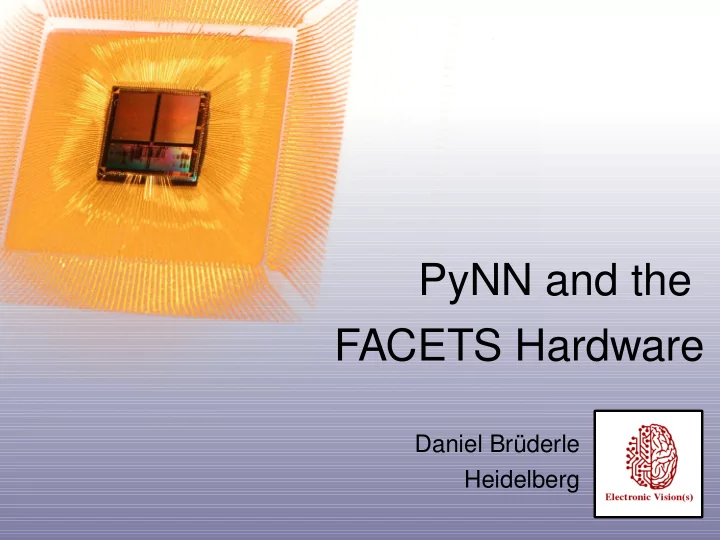

PyNN and the FACETS Hardware Daniel Brüderle Heidelberg
FACETS Hardware: Recap „Neuromorphic“ Hardware: A physical model, not a simulation ● Intrinsically parallel, scalable, fast, ... ● Not an arbitrarily flexible substrate – fixed neuron model – limited ranges for neuron and synapse configuration parameters – limited resources ● neuron number ● connectivity / synapse number ● max. firing rates ● individual configurability
FACETS Hardware: Recap ● Three FACETS groups design and build neuromorphic hardware – Bordeaux: High-precision systems ● mixed-signal VLSI HH model ● real-time ● ~ 10 0 - 10 2 neurons – Heidelberg / Dresden: Large-scale accelerated system ● mixed-signal VLSI I&F model ● highly accelerated (speedup factor ~ 10 4 - 10 5 ) ● ~ 10 2 – 10 6 neurons ● 2 stages of development...
Accelerated FACETS Hardware ● Stage1 (chip-based): Conductance-based I&F neurons – 384 interconnectable neurons on each chip – programmable connectivity ● source, target, weight, tau_syn – chips interconnectable – STDP (analog, on-chip) – short term dep / fac – no spike-frequency adaptation
Accelerated FACETS Hardware ● Stage 2 (waferscale integration): Adaptive EIF a la Brette & Gerstner ~ 10 5 dendritic building blocks and – ~ 10 7 synapses per wafer wafers interconnectable – – STDP (digital, on-chip) – short term dep / fac
Status Hardware (May 2008) ● Stage 1: up and running Problems with analog parameter storage ● – temperature dependent leakage currents at synapses, also at voltage and current memory – hard to control e.g. STDP – hard to quantitatively compare results to e.g. NEST Only subset of neurons readable at the same time ● New, bug-fixed chip available since 1 st of May ● – stable parameters – all neurons recordable at the same time
Status Hardware (May 2008) Stage 2: final stage of development ● – neuron and synapse model decided, prototype for parts of the model available (Stage 1 chip) – connectivity and routing issues decided, methods for network mapping existing, under further development and testing – new analog floating gate memory developed and successfully tested – wafer post-processing successfully tested – prototype for digital long-distance and off-wafer communication available – first full system expected during 2009
Why PyNN for the FACETS Hardware? ● Only little neuroscientific expertise in hardware groups ● Plan: Hardware as a useful research tool for modelers' community – statistics-intensive, large parameters sweeps, long-term learning, etc – interweaved hardware software co-simulation ● Needed: Access and usability for every FACETS member
Why PyNN for the FACETS Hardware? ● Python and PyNN provide – easy-to-learn, well documented user interface for non-hardware-specialists – experiment porting – quantitative result comparisons ● e.g. for hardware model verification – analysis and post-processing tools Plans to adopt PyNN also for the Bordeaux hardware system ● and by e.g. Giacomo Indivery (DAISY)
Status PyNN.hardware ● Started with basic interface: Very hardware-specific C++ API ● At CodeJam #1: plain Python interface (boost), no connection to PyNN ● Now: PyNN supported as far as possible („ pyNN.hardware.stage1“ ) – procedural API ● hardware well hidden – seems to behave like e.g. NEST, just faster ;) ● reasonable default values for hardware parameters ● voltage recording via oscilloscope + c++-sockets + boost.python – after Code Sprint in Debrecen: Populations / Projections – standard output formats – neuron model IF_facets_hardware1 – warnings / errors for constraints
PyNN procedural and object-oriented API supported own neuron model Hardware abstraction layer PyHAL Object-oriented, user friendly, full chip functionality Boost.Python Python 1:1 translation of all relevant classes C++ Hardware specific low-level API config input output
Status PyNN.hardware Drawbacks: ● – no voltage recording of all neurons at the same time – limited parameter ranges (weights, voltages, time constants...), hardly handled so far – every run is different... ● leakage ● temperature ● crosstalk ● power supply ● ...
Hardware Specific Implementations ● Temporal resolution („timestep“): Sampling rate oscilloscope ● Additional parameters – work station (chip) selection – translation factors ● weights ● temporal speedup – mapping parameters – calibration data (files for every workstation) Unused parameters ● – min_delay, max_delay
PyNN.hardware in the Official Trunk? Plans as decided in Debrecen: ● Provide everyone with a lightweight dummy PyNN.hardware module – full PyNN.hardware module necessary only in Heidelberg – dummy module implements all errors and warnings that arise due to hardware specific constraints – for offline testing of scripts – run routine returns only „script executable“ or „script not executable“
Further Plans Include Graph Model (for mapping networks to the hardware ● configuration space, see lightning talk by Johannes Bill) ● Clean handling of limited parameter ranges ● Memory management for large numbers of experiments – Direct correspondence / mapping from high level data structures to allocated experiment objects in hardware playback memory
Hardware Model Verification presented at the IWANN 2007
Recommend
More recommend